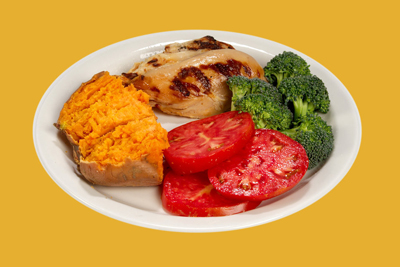Mar 16, 2018Time for Dinner
Dinner is most likely to be a student-athlete’s one “sit down” meal of the day. It’s the best time to customize their simple meal plan to assist with individual body composition goals. For instance, those looking to build muscle can place a larger emphasis on higher-calorie, protein-rich foods like red meat, poultry, nuts and legumes, while those looking to lose weight can fill up on high-fiber, low-calorie fruits and vegetables.
As a general rule, an optimal dinner plate should be broken into three parts: Roughly 50 percent should be higher-fiber carbohydrates like bread, other grains, and starchy vegetables such as potatoes, 25 percent should be whole vegetables and fruits, and 25 percent should be low-fat proteins. The portions should be large enough that the athlete won’t feel hungry again later in the evening, with the possible exception of a late-night snack.
The options in the “Dinner” chart below are broken down by the two most common body composition goals for athletes–muscle mass gain and weight loss. For those looking to lose weight, portion size is especially important: If they skimp on the portions of healthy dinner foods in an attempt to take in fewer calories, they’ll likely be tempted to eat more later in the evening, and it’s easy to make bad choices when you’re hungry late at night. Meanwhile, those looking to gain weight or muscle mass should avoid drinking too much with their meals, as the extra fluid will cause feelings of fullness to set in more quickly.
For Losing Weight
• Grilled chicken breast
• Two cups of cooked or raw veggies
• Piece of whole fruit
• Large glass of low-fat milk
• Club salad: lean lunch meat, low-fat cottage cheese, two cups of veggies, beans (garbanzo, pinto, etc.), and low-fat salad dressing
• Whole fruit or fruit salad
• Low-fat milk or fruit juice
• Simple stir fry: sautéed vegetables (broccoli, cauliflower, zucchini, celery, carrots, etc.) with chicken, pork, thinly sliced beef, and/or scrambled egg
• Use teriyaki or soy sauce as seasoning
• Baked potato topped with low-fat turkey chili and grated low-fat cheese or parmesan cheese
• Piece of whole fruit
• Low-fat milk or fruit juice
For Gaining Muscle
• Grilled chicken, pork, fish, or steak
• White or brown rice
• Steamed or raw carrots
• Low-fat milk (after meal)
• Pasta with tomato sauce, cooked extra-lean ground beef, and parmesan cheese
• Dinner roll with trans fat-free margarine
• Low-fat milk (after meal)
• Lasagna with beef or chicken and extra tomato sauce
• Plain French bread or whole-grain rolls
• Low-fat milk (after meal)
• Large bean, cheese, and chicken burrito with salsa
• Small mixed green salad with Italian dressing
• Fruit juice (after meal)
Image by CDC/Fenley




